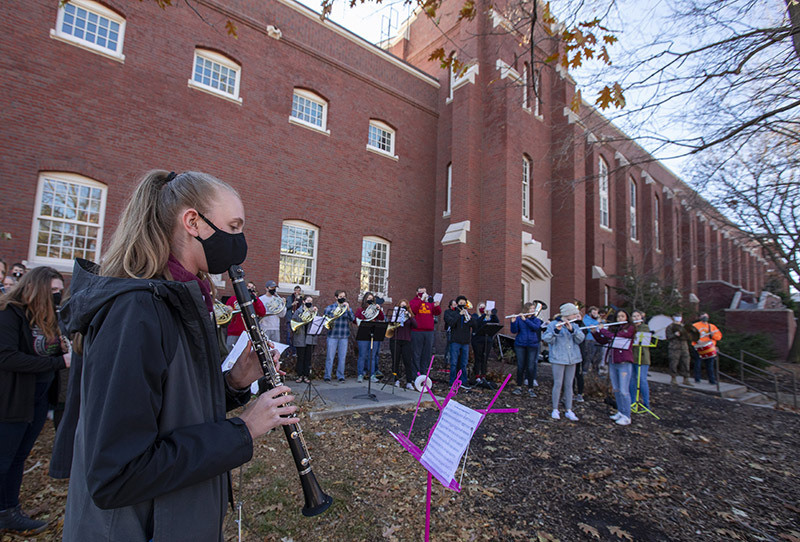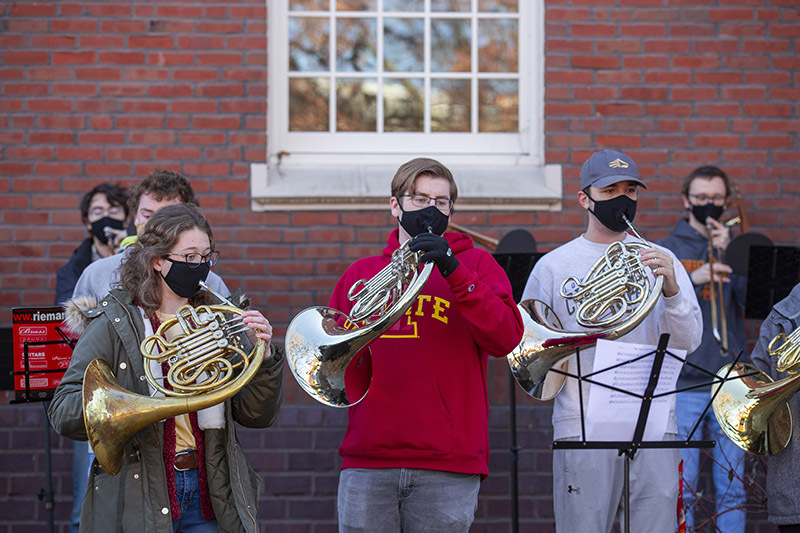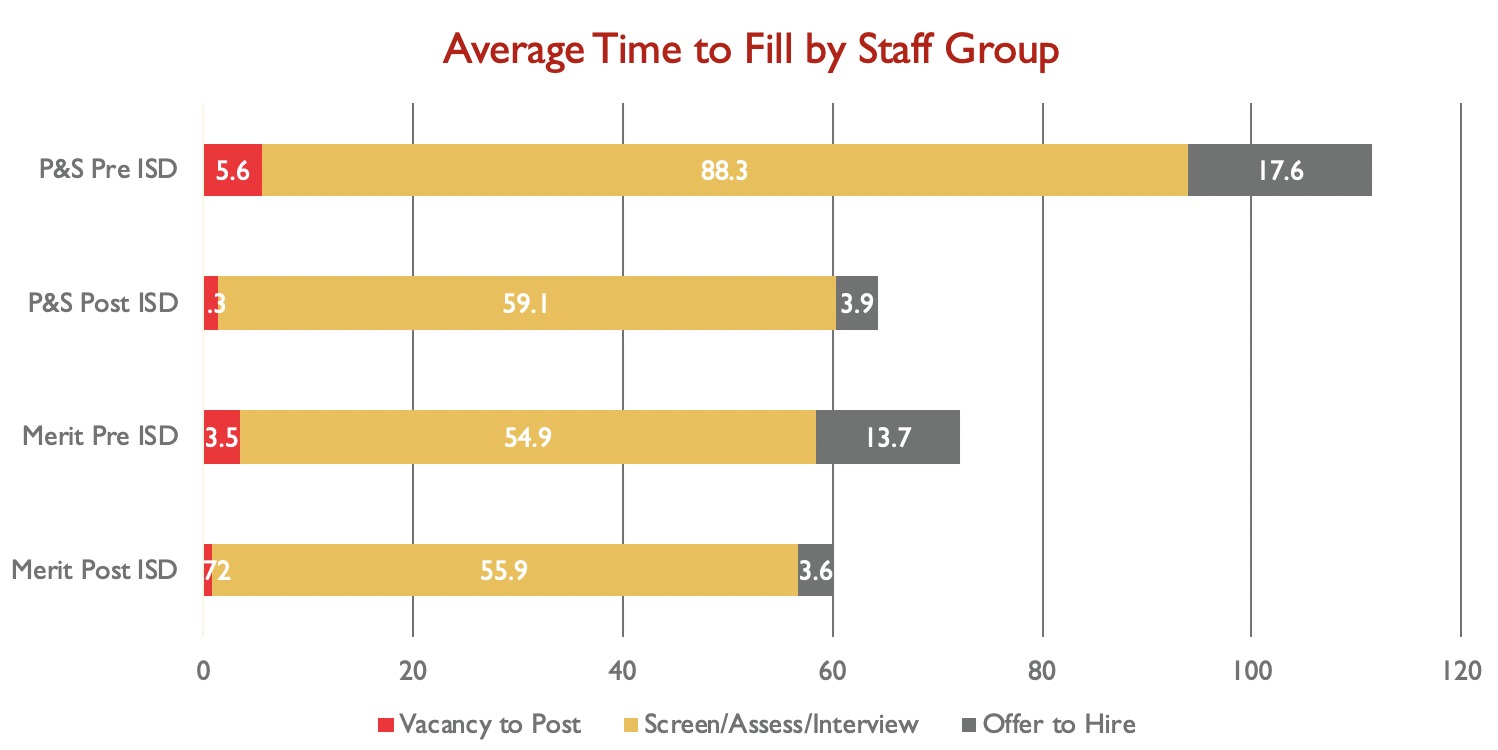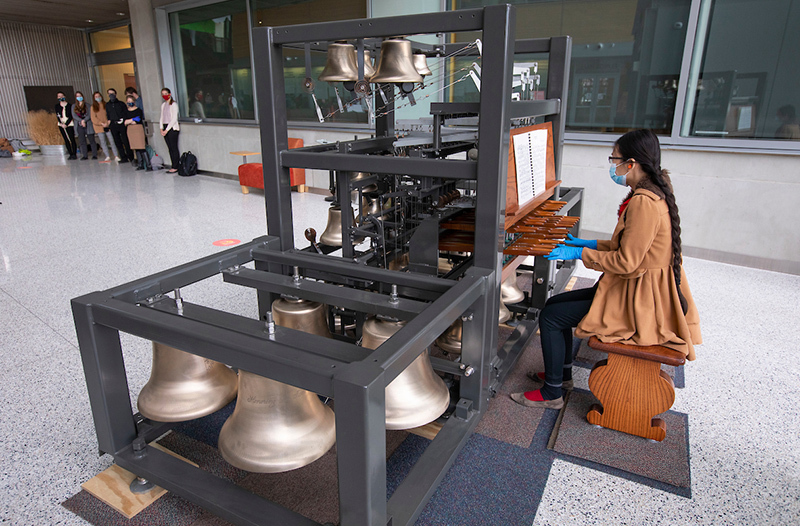A Sousa celebration

Haley Dostalik, left, plays the clarinet as members of the ISU Wind Ensemble and Symphonic Band play "The Stars and Stripes Forever" by John Philip Sousa outside State Gym on Veterans Day, Nov. 11. The day marked the 100th anniversary of a concert by the John Philip Sousa Band in State Gym. Photos by Christopher Gannon.
On Nov. 11, 1920, the John Philip Sousa Band played an Armstice Day concert inside State Gym, a matinee show that marked the only Ames performance by the renowned composer and conductor.
Exactly 100 years later, the ISU Wind Ensemble and Symphonic Band celebrated the same holiday, now known as Veterans Day, in (nearly) the same spot.
The plan before the pandemic was a special Sousa-style Veterans Day concert in the evening to celebrate the holiday and the 100th anniversary of the performance, said Michael Golemo, ISU director of bands.
Though COVID-19 scuttled that plan, the student musicians were still able to provide a piece of the celebration, playing the national march written by Sousa, "The Stars and Stripes Forever," in an outdoor and masked performance north of State Gym, keeping with Cyclones Care protocols.

From left, Holly Kirchhoff, Aidan Nelson and Tyler Cummings play the French horn during the ISU Wind Ensemble and Symphonic Band's Nov. 11 performance of "The Stars and Stripes Forever" outside State Gym.
Recruiter support making staff job searches better and shorter

A job search that drags on longer than needed is a pain for all involved. It's draining for hiring managers, a strain on the current staff and off-putting for candidates.
All of which has been less of a problem at Iowa State since mid-2019, when a team of staff recruiting specialists was created as part of the launch of Workday and service delivery teams. In fiscal year 2020, which ended June 30, the average time it took to fill a P&S job fell from 112 days to 63 days. Time-to-fill for merit jobs dropped from 72 days to 60 days.
A quicker search makes it easier to hire quality applicants, said Becky Etnier, talent acquisition manager for university human resources (UHR). Strong candidates may be in the running for other positions and unwilling to wait on a pending search. Regardless, applicants consider their interactions with a potential employer before accepting an offer. In a survey by CareerArc, Etnier said, 63% of job seekers said they would likely reject an offer from an employer if the hiring process was poor, and 72% would tell others about it.
Reducing the days a position stays vacant also has significant benefits for current employees who have to take on more and hiring managers who have to find time for a search while already short-staffed, said Kristi Darr, vice president for UHR.
“This model delivers service and support to all involved. We are truly appreciative of the hiring managers who trusted us to provide this new service. Their feedback has been so valuable as we continue to work to improve the process,” Darr said.
Staff recruiting team
Members of the staff recruiting team and the service team or role they serve:
- Clayton Byrd (Junior staff recruiting specialist)
- Jeri Derrig (Aspen, Fir, Redwood)
- Betsy Happe (Pine, Spruce)
- Lindsay Moeller (Hickory)
- Luisa Orticelli Pinto (Birch, Dogwood, Juniper)
- Teresa Rummer (Sycamore)
Factors in moving faster
In a presentation to the P&S Council at its Nov. 5 meeting, Etnier credited the substantial reduction in staff hiring times to a couple of main factors.
One was a policy change adopted at same time as the July 1, 2019, rollout of Workday, service teams and staff recruiting specialists: The minimum length of a job posting for a P&S job, previously either 15 or 30 days, was shortened to seven days. Etnier said the majority of P&S jobs post for the seven-day minimum. Merit system rules require posting jobs for at least 10 days.
"The faster we can go through the process, the more likely we are to keep a candidate engaged," she said.
Having the recruiting team conduct screening interviews of eligible candidates by phone on a rolling basis as they apply also contributed to improved hiring turnarounds, said Etnier, who oversees the team of five staff recruiting specialists and a recruiting coordinator. That streamlines the search for managers and helped cut the screening, interviewing and assessment portion of an average P&S hire from 88 days to 54 days.
How it works
When a staff position opens up, the hiring manager's first stop is a workforce planning conversation with an HR partner or coordinator, Etnier said. That covers the need, purpose and nature of the position, which leads to identifying an appropriate job profile.
Next comes an intake meeting with a recruiting specialist looking for in-depth information about the position, such as the day-to-day responsibilities, what success looks like in the role and the supervisory style of the hiring manager.
"These planning meetings set the entire recruitment process up for success, so when recruiting specialists talk to candidates, they have a good grounding about the job itself," Etnier said.
In the intake meeting, the manager and recruiting specialist discuss strategies for attracting a strong, diverse field of candidates and how the hiring process will work. Supervisors can be as involved as they'd like, but the best practice is to have a recruiter contact eligible candidates for short screening interviews. Those calls provide a chance for both parties to ask questions and, when conducted as applications are received, are key to a quick job search and engaged candidates.
From there, a recruiting specialist can provide the manager with a pool of possible finalists and help develop interview and assessment plans. After a supervisor decides who to formally interview and hire, a recruiting specialist can consult and conduct offer negotiations and support new-hire onboarding. The full-cycle service has helped reduce the need for search consultants and committees, though involving current employees in interviews and assessment is still recommended.
"It's a much more focused utilization of people to help make hiring decisions," associate vice president for human resources services and strategy Dwaine Heppler said of using interview panels instead of search committees.
What's next
Since the summer 2019 go-live, several Workday updates have refined how the platform handles job applications. Candidates can save and review applications before and after submitting, for instance -- a capability that wasn't available at first.
An update effective Nov. 2 allows job postings to close for guaranteed consideration at the end of the day listed as the deadline, instead of the 12:01 a.m. closing time that was the only option before. Having postings close at the start of the day listed as the deadline was a frequently noted concern by managers and candidates.
Also beginning Nov. 2, P&S and merit hiring managers and hired candidates will be asked to complete a post-search survey to find areas for improvements, Etnier said.
"We've got the bar set pretty high, but we need to continue to make enhancements and improve the process," she said.
Etnier said the recruiting team also is looking at making the staff employment application process more accessible on mobile devices. That includes more concise job postings and limited supplemental questionnaires, relying on phone screenings to collect information previously submitted with each application. Those adjustments would help the university grow its recruiting footprint on social media, another future goal.
"That's really where candidates are today," she said.
Wickert summarizes pay equity study for senate
Senior vice president and provost Jonathan Wickert presented some of the results of the pay equity study at the Nov. 10 Faculty Senate meeting.
The study, at the university and college level, was conducted by Aon, a human resources consulting firm, and focused on pay equity in 2017-18 of 1,912 faculty members according to gender, race and ethnicity.
"This study was commenced in 2018 and used an external organization because the previous study -- eight or 10 years ago -- was done internally," Wickert said.
It concluded there was no evidence of systemic bias in faculty base pay by gender or ethnicity, but two areas of concern were identified. The College of Veterinary Medicine (CVM) and the College of Design were recommended for further review because of pay gaps.
The study found female faculty in CVM were paid 7.8% less than men. Non-white faculty were paid 6.6% less in the College of Design than their white counterparts.
"The deans of those two colleges did their own study and the College of Veterinary Medicine ended up making 15 adjustments," Wickert said. "The College of Design made 17 adjustments that were completed last year."
Term faculty
Senators approved a Faculty Handbook revision to clarify term faculty ranks to ensure teaching faculty are treated fairly with multiyear contracts and notice of non-renewal.
Lecturers are appointed for up to one year, but after three consecutive years become a term assistant teaching professor. Assistant professors are appointed from one to three years, and after completing three straight years the length adjusts to two to three years. Associate term faculty are hired for three to five years, while term professor contacts are for three to seven years.
Practice-track faculty can be hired regardless of previous employment at the university. Assistant professors of practice can be hired for up to three years, associate professors of practice up to five years and professors of practice up to seven years.
All appointments require a one-year notice of intent not to renew. Appointments of a year or less require three months' notice.
The senate also passed a resolution in support of faculty who were not credited with prior time served at a rank because of a misinterpretation in chapter 3 of the Faculty Handbook (3.3.2.3). The resolution asks administrators to rectify the misinterpretations as quickly as possible.
Graduating with distinction
The senate will vote at its December meeting on changes to the graduation with distinction policy in the university catalog. As proposed, undergraduates can graduate with distinction if they have at least a 3.50 cumulative GPA after meeting all degree requirements. Most bachelor degree candidates must complete 60 credits at Iowa State with a minimum of 50 graded credits. Bachelor of liberal studies degree graduates must complete 45 credits at state Board of Regents universities and have at least a 3.50 GPA at ISU, but the distinction is based on a combined GPA at the regent universities. Bachelor of science in nursing grads must complete 32 credits at Iowa State.
Workbooks
Finance service delivery will begin implementing the new financial report workbooks for primary investigators and faculty. In a memo to the senate, associate vice president for finance and support services Heather Paris said the goal is to complete implementation by the end of the fall semester.
Financial report workbooks can be customized to faculty preferences in Workday and scheduled to refresh monthly with live data. Cost center managers will assist in developing a template of worktags and provide final review of workbooks before they are distributed. Primary investigators or faculty members can contact their finance service delivery team member to learn more about workbooks.
Other business
Senators voted to approve:
- Faculty Handbook changes that replaced some gender-based pronouns to they/their.
- A master's in artificial intelligence offered by the computer science department. The 31-credit program will allow students to compete for national positions in a high-demand field. No other state Board of Regents university offers this graduate program.
- Discontinuation of the Graduate College's master's and doctoral interdisciplinary programs in biorenewable resources and technology. Enrollment is down 90% since 2002 and no new students have been admitted in the past three years.
The senate will vote next month on:
- A beverage management minor in the apparel, events and hospitality management department. The minor, requiring 15 credits, will prepare students to understand the intricacies of the development of beverages, their use and the operation of a beverage establishment. No other regent university has a beverage management major or minor.
- A name change for the child, adult and family services major and minor to human development and family studies. It brings the university into alignment with peer institutions and helps students better identify the program.
- A minor in ethics in the philosophy and religious studies department. The 15-credit minor will explore theories and applied topics in ethics and provide background for students in business, law, agriculture, medicine, psychology, education and other fields.
Additional grant will help with pandemic costs
A grant of nearly $550,000 will allow Iowa State to recoup some pandemic-related expenses specifically related to IT access and connectivity. The grant from the Iowa Department of Education is based on Iowa State's number of federal Pell Grant-eligible students. Last month, the department distributed about $4.4 million among Iowa's public and private colleges and universities and community colleges according to this metric. This funding is part of the federal coronavirus aid bill (CARES), coming via the $3 billion Governor's Emergency Education Relief (GEER) Fund.
Professional development grant
A second GEER fund, totaling $1.5 million, will be distributed among Iowa colleges and universities as competitive grants for professional development in support of online instruction. Grant proposals are due Dec. 11.
Associate vice president for institutional financial strategy Bonnie Whalen is coordinating the large task of assembling records for more than $20 million in many kinds of pandemic-related costs and processing paperwork for reimbursement from GEER funds, the Federal Emergency Management Agency (FEMA) and spring CARES funding for institutional expenses.
"Our goal is to use the appropriate funding sources to recoup as much of our investment in this response as possible and reduce the COVID impact on the university's operating budget," she said. "Each source has specific criteria and limitations we need to follow."
For example, the GEER funds could cover IT initiatives such as laptop purchases for the student loaner program, central campus and stadium drive-up Wi-Fi zones, or software licenses and classroom technology upgrades that support virtual teaching. There's not enough GEER funding to cover all that, she acknowledged. IT projects are not eligible for FEMA reimbursement.
The first step Whalen said, is to maximize eligible FEMA reimbursements. Knowing what FEMA accepts and rejects will influence how Iowa State uses other funding sources. She said her initial focus has been on large university initiatives that serve many such as face coverings, hand sanitizer dispensers, additional custodial teams and the Cyclones Care campaign.
FEMA normally will reimburse 75% of the cost of an emergency-related project. She anticipates a response from FEMA by the end of December on the university's initial requests.
The spring CARES funding has broader eligibility criteria. Examples of allowable expenses include IT projects and housing and dining refunds to students.
The university will continue to track expenses that could be eligible for FEMA reimbursement, but Whalen said it's now a smaller group of projects. Effective Sept. 15, FEMA is supporting expenses that remain a direct response to the COVID-19 disaster -- for example, testing, quarantine and isolation costs -- but not expenses incurred because the university opted to be an open campus this fall. Preventative measures since Sept. 15, for example, hand sanitizer stations, may not be reimbursable.
Learning community for faculty tackles teaching, technology issues
ISU Online Learning Community
When: Friday, Nov. 13; 11:30 a.m.-1 p.m.
Where: Register free online
FYI: The learning community meets monthly to share campus best practices to improve online teaching and learning.
The pandemic has taken away so much people take for granted -- even pizza.
The Center for Excellence in Learning and Teaching (CELT) leads the ISU online learning community, and with its monthly meetings no longer taking place in person, faculty, staff and graduate assistants can't work through an issue over a slice of pizza. Helping instructors find new ways to be successful hasn't stopped, it just moved online.
CELT instructional technology specialist Lesya Hassall works to keep faculty and staff engaged around teaching and technology advancements that can benefit them and their students.
"The pizza is gone for now, but I still work to give them food for thought," she said. "We want them thinking about what will broaden their teaching and improve their students' learning after attending."
Finding comfort in technology
The learning community -- which has been active for more than five years -- saw a spike in participation last spring when the pandemic forced a move to virtual instruction, and again to begin this semester as instructors adjusted more courses.
Each meeting focuses on digital pedagogy and Canvas updates important to instructors. It is a chance for participants to discuss issues and find solutions.
"One of the most successful things about the learning community is the ability to tap into the amazing things faculty are already doing on campus," CELT instructional technology specialist Gretchen Anderson said.
Anderson has seen instructor confidence grow in using Webex, preparing recorded lectures and integrating their digital classroom with in-person instruction. One key for instructors to be successful using Canvas is to talk and learn from other instructors, she said.
Next meeting
Recent conversation has focused on testing and preparing for final exams. Questions of how best to administer tests online and ensure their integrity are common. The next meeting on Nov. 13 will focus on testing.
Hassall said faculty and students are equally stressed about end-of-semester assessments this fall.
"The ability to really narrow down what you are trying to assess is key," Anderson said. "Don't worry about the technicalities of how you will assess, but first think about what you really want students to know. From there, it is much easier to figure out how to make it happen."
Associate professor of chemical and biological engineering Monica Lamm, who serves as a CELT faculty fellow, will discuss alternative ways of conducting review sessions for assessments and creating tests.
Lamm recently began using the public exam system in her courses. She is transparent about what type of questions will be asked on the exam, without giving students the questions.
"It is a way to use the learning outcomes with students as a guide and show them how to prepare," she said. "You get the student engaged by having them figure out how they would ask a question that would test their understanding of the topic. They get the framework of the question, and that can be discussed and used as a way to study."
Using online breakout rooms led to positive discussion and brought more student questions to the larger group for clarification, Lamm said.
New ways of assessing student performance are important for virtual instruction because many previous methods don't translate online, Lamm said. Providing new ideas gives instructors something to implement or tweak for their own classes.
Transitions announced in School of Education
Several leadership transitions were announced this week in the School of Education.
Don Hackmann, the school's director, will step down from his role effective Nov. 13 and retire from the university Dec. 31. Hackmann, a professor of educational leadership who also serves as the Frances S. and Arthur L. Wallace Professor, began his service in June 2019.
"Dr. Hackmann has served the School of Education with distinction during his time on campus, including navigating the transition to virtual learning in spring 2020 and preparing for the fall semester amid the COVID-19 pandemic," said Laura Jolly, dean and Dean's Chair of the College of Human Sciences. "We are very grateful for his service and stewardship of the school, and we wish him the best as he transitions into retirement."
In addition to Hackmann's retirement, associate director Denise Crawford and director of graduate education Anne Foegen have stepped down from their respective roles.
Jolly will announce interim leadership in the coming weeks and host a series of meetings with the school's faculty and staff.
The School of Education was created in 2012 by merging the departments of curriculum and instruction and educational leadership and policy studies, their associated research centers and the university's educator preparation program.
Hilton capacity set at 10% for basketball season
The athletics department has announced plans for the basketball season that will cap attendance at 1,373 fans per game, or just under 10% of Hilton Coliseum's 14,384-seat capacity. Only season ticket holders for the men's and women's programs will have an opportunity to purchase single-game tickets, about 75% of which will be in the arena's upper level.
"The safety of all participants and fans remains our top priority," Cyclone athletics director Jamie Pollard wrote in a Nov. 5 letter to fans, noting that community or campus COVID positivity rates could compel him to modify the fan plan during the season.
Mitigation strategies for basketball fans will include face coverings for everyone all the time, assigned seat pods that are physically distanced, hand sanitizer stations throughout Hilton and additional sanitizing of high-touch surfaces. Concession stands will only sell bottled beverages, though fans may carry in snacks in a clear bag. Eliminated for this season are printed programs, team posters, postgame autograph sessions, cheer giveaways for fans, T-shirt tosses and courtside seats. Fan venues at Johnny's (Hilton) and Stagedoor (Scheman) will remain closed. And as with volleyball home contests this fall, the seating ring closest to the court known as arena circle will be recessed to create more sideline space for the teams and score table officials and limit access to the main floor.
Ticket purchases
The men's basketball team is scheduled to play at home 14 times this season, including five nonconference games and nine conference games. The women's team is scheduled to play in Hilton 13 times, including four nonconference and nine Big 12 Conference games. Single-game tickets will be sold to interested season ticket holders Nov. 13-20 in a staggered schedule based on Cyclone Club donation levels. Depending on availability at the time of purchase, season ticket holders could buy tickets for up to seven home games spread across the three-month season. Ticket purchases will include single-game parking passes.
Pollard noted that regardless of whether they purchase single-game tickets this year, all 2019-20 season ticket holders will have first rights to their tickets and seat locations for the 2021-22 season.
According to the Hilton basketball seating plan, 904 seats will be reserved for season ticket holders or the public, 148 for ISU student fans, 84 for family and friends of ISU players and coaches, 50 for the pep band and spirit squads and 50 for fans of the visiting team. The rest (137 seats) are reserved for game operations, media, athletics department staff, guests of Cyclone Sports Properties and fans requiring accessible seating.
Pollard said fan plans at Hilton for the Cyclone gymnastics and wrestling seasons will be shared soon.
Carillon students will perform Friday in Sukup atrium

Cavannah Yap, a senior genetics major, plays during the Oct. 16 student concert in the Sukup atrium. Photo by Christopher Gannon.
Carillon students studying with university carillonneur and Cownie Professor of Music Tin-Shi Tam will perform during a Nov. 13 concert. The one-fifth scale campanile and carillon model on display in the Sukup Hall atrium will be used for the 12:30 p.m. recital.
Spectators may attend in person while observing face covering and physical distancing requirements. The performances also will be livestreamed on Facebook by the ISU Society of Carillon Alumni and Friends.
Carillon concert program
Carolyn Riedel, graduate student, aerospace engineering
-
"Prelude from Cello Suite No. 1, BWV 1007," Johann Sebastian Bach
Rebekah Veldboom, freshman, environmental science
-
"Clock Music, Set 2, No. 6," George Frideric Handel
-
Variations on "Twinkle, Twinkle Little Star," arranged by Leen 't Hart
Ola Carnahan, senior, aerospace engineering
-
"Tranquility," an Appalachian folk song
Cavannah Yap, senior, genetics; with Aaron Eckley (vocal) and Jim Wang (vocal percussion)
-
"Don't Stop Believin'," Journey
